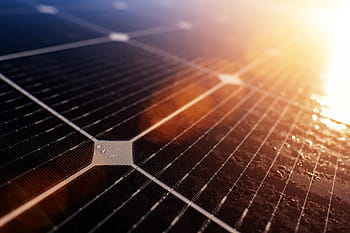What type of panel do you need? How long will they last? How much power will they make? Why are secondhand panels often a better choice than low end new ones?
TL;DR: The overall quality of the panel is more important than weather the cells are monocrystalline or polycrystalline. Look for a house panel or a reputable manufacturer.
You may have heard of monocrystalline and polycrystalline solar panels. Specifically, you may have heard that monocrystalline panels have a higher efficiency and better overall performance.
There are three major categories of solar cell currently available to the average consumer (reasonable price per kW – I’m waiting for Perovskite cells to come down) – monocrystalline, polycrystalline, and amorphous or thin film solar panels – all made from silicon. These three technologies all work along the same lines in terms of turning sunlight into usable electrical energy (more on that later).
The main difference is in how the cells are constructed.
Solar Panels – What are the differences?
Monocrystalline cells are large cylindrical crystals that are cut into thin wafers. In ye olde monocrystalline panels they used these circular cells as is but in modern panels they cut out most of the curve to save space – you can still see the curved edge on the corners. In addition to slightly higher efficiency, Monocrystalline panels tend to have a slightly higher heat tolerance than polycrystalline.
Polycrystalline cells are multiple silicon crystals that have been melted down and moulded into a square shape. They are cheaper and less wasteful to produce. 20 years ago they also had a much lower efficiency however a modern 300W panel will typically be the same size weather it is monocrystalline or polycrystalline, with a few exceptions. Polycrystalline cells are generally more resilient to vibration and less likely to crack, but more prone to ‘snail trails’ – a fault where the current collectors begin to corrode, possibly due to impurities in the crystals.
Amorphous cells are ‘printed’ (at high temperature) directly onto the glass. They are extremely thin and tough. High – end flexible panels are made from amorphous silicon. Amorphous cells generally produce less power per square meter than the older styles of panels – i.e. are less efficient, but they are also less affected by heat, partial shading, and work better with indirect lighting. Over the course of a year, an amorphous panel could produce more energy than a higher wattage monocrystalline panel, depending on the conditions.
So what do you go for? The cells themselves are not the most important part – you see, most solar panels actually stop working when the diodes in the back blow, or when the plastic backsheet breaks down and allows water ingress. In high voltage systems snail trails can lead to earth faults but for systems where you have up to two panels in series you aren’t going to see significant problems until water gets to the current collectors. As ‘house panels’ have to meet a minimum requirement in terms of effective lifespan, they use better quality (and fire retardant!) plastic. Whilst many systems are being pulled down after 5 – 10 years, mainly for upgrades as the maximum inverter size for grid tie systems has increased, the standard requirement is that they will still be outputting 80% of their rated output at 25 years old, with some brands expanding on that up to 35 years.
House panels typically use a silver alloy current collector that expands and contracts at the same rate as the glass whilst low end 12V panels often use aluminium which will eventually develop kinks and cracks as it expands at a higher rate. Cheap flexible panels are made from monocrystalline cells which develop cracks very easily and only last a few years.
There are other differences of course. Some companies make more flexible cells. Some use a transparent current collector that boosts efficiency by not blocking out any of the sun light. At the end of the day, house panels are actively regulated and properly constructed they are an extremely reliable technology.



